Tiptop Audio Time Fabric Handleiding
Tiptop Audio
Niet gecategoriseerd
Time Fabric
Bekijk gratis de handleiding van Tiptop Audio Time Fabric (8 pagina’s), behorend tot de categorie Niet gecategoriseerd. Deze gids werd als nuttig beoordeeld door 47 mensen en kreeg gemiddeld 4.2 sterren uit 24 reviews. Heb je een vraag over Tiptop Audio Time Fabric of wil je andere gebruikers van dit product iets vragen? Stel een vraag
Pagina 1/8

Time Fabric
Pitch Programs for Z-DSP

Time Fabric’ Pitch Programs for Z-DSP
“It fucks with the fabric of time!”
Tony Visconti describing Pitch Shifting to Brian Eno and David Bowie in 1976
That not so subtle description does quite neatly sum up what the Pitch Shift programs on the
‘Time Fabric’ card do! In the second half of the 1970s, digital technology became ‘aordable’
enough to start showing up in professional audio equipment. Digital memory allowed the
sampled audio to remain in memory without degradation and this ability led not only to delay
and reverb devices, but some clever people (like Tony Agnello at Eventide) found that playing
the samples back at a dierent rate than recorded produced pitch changes. With some careful
engineering this eect could work in real time on any audio signal, and thus pitch shifting
emerged.
First, Lexicon released their Varispeech device aimed at aiding in transcription and speech
research (dubious for the intended use, but great at mangling sounds), but it was really the
Eventide H910 ‘Harmonizer’ that made Pitch Shifting a must have eect. Although designed to
provide automatic ‘Harmony’ for any signal, the eect was so wild and new it became instantly
recognizable when abused. Pitch shifting became the method for the wacky sounds and voices
on P-Funk records, snare drum on the above mentioned Bowie album ‘Low’, and any male voice
shifted down an octave became the voice of Satan in countless 80s horror lms.
Pitch shifting would eventually have both more experimental applications like the Eno/Lanois
‘Shimmer’ and crazy backwards Eventide ‘Crystals’ eects, but also be relegated to mundane
tasks like doubling country music vocals and widening hair metal guitars. Both paths have
made Pitch Shifting into an essential eect for any studio and now your Eurorack rig.
This collection of Pitch Programs for the Tiptop Audio Z-DSP module use a pitch shifting algori-
thm much like the earliest digital pitch shifters released. Sounds similar to the Eventide H910,
AMS 15-80 (with Pitch board) and Publison DHM 89 can be achieved. These programs are
intended more for pure eects rather than the complex multiple harmony lines later devices
and plugins became known for producing. Chords from single VCOs can easily be made using
the ‘Interval’ programs on the card though.
Pitch shifting in the Z-DSP uses a technique called ‘rotating tape head’ delay lines named after
pioneering tape based experiments in Germany in the 1960s. The tape heads move at speeds
independent of the tape playback path and two heads are crossfaded to make a continuous
output. Much of Karlheinz Stockhausen’s output of that era heavily (ab)uses the two tape
machine method of changing pitch. Digital memory and processing allows the same method
by manipulating two playback positions in memory and crossfading them using DSP. This is a
fairly primitive process compared to what can be done today using FFTs (phase vocoder) and
Time Compression and Expansion, but there is a certain sound associated with it that is unde-
niably classic.

The rst 6 programs all use the same basic algorithm for independent processing of the Left
and Right Inputs on the Z-DSP. The algorithm looks like this:
Left In ---> Pitch Shifter ---> Delay Line ---> Left Output ---> [Analog Feedback to Left In]
Right In ---> Pitch Shifter ---> Delay Line ---> Right Output ---> [Analog Feedback to Right In]
The dierences in the programs come from the controls and their ranges to give more access to
certain parameters of the algorithm and make certain eects easier to create.
The delay lines have roughly 500ms of delay on the Left and 250ms on the Right channel. This
gives a nice 2:1 rhythmic eect to the delay.
1> Dual Pitch Shift
Has independent control of the Pitch of the Left and Right channels and combined Delay
time control. The delay for the Right channel is half of the Left channel to give rhythmic
variation between the two.
VC-P1 - Pitch shift of the Left channel from -1 to 1 octave
VC-P2 - Delay time of both channels. Left < 500ms; Right < 250ms
VC-P3 - Pitch shift of the Right channel from -1 to 1 octave
The Pitch control is not quantized so it can be tuned (or not) by ear. For very small shifts
under 1 semitone, use Program #5 Dual Microshift. Programs 3 and 4, Interval shift, will
tune the Pitch to specic intervals.
The delay line feedback is controlled using the Analog Feedback for each channel. This
also puts the Pitch Shift in the feedback path to create arpeggios and other eects.
2> Dual Delay Shift
The same algorithm as Program #1 but with independent control of the delay times. Left
delay line has roughly 500 msec of delay at the default sample rate. The delay for the
Right channel is half (250 msec) of the Left channel to give rhythmic variation between
the two.
The pitch ratio between the left and right channels are inverted, so a positive shift on the
Left will be a negative shift on the Right. The maximum shift is one octave up or down.
VC-P1 - Delay Time of the Left channel from 0 to 500 msec
VC-P2 - Pitch Shift of Left and Right. The shift amount is inverted between channels
VC-P3 - Delay Time of the Right channel from 0 to 250 msec
Product specificaties
| Merk: | Tiptop Audio |
| Categorie: | Niet gecategoriseerd |
| Model: | Time Fabric |
Heb je hulp nodig?
Als je hulp nodig hebt met Tiptop Audio Time Fabric stel dan hieronder een vraag en andere gebruikers zullen je antwoorden
Handleiding Niet gecategoriseerd Tiptop Audio
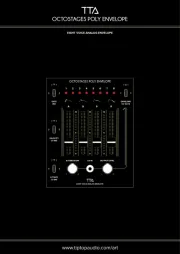
5 Augustus 2025
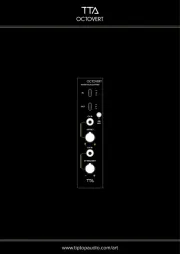
5 Augustus 2025
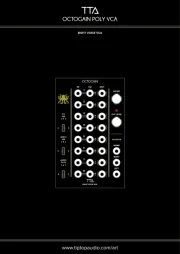
4 Augustus 2025
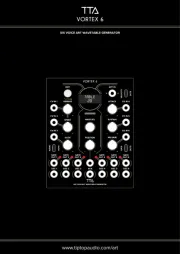
4 Augustus 2025
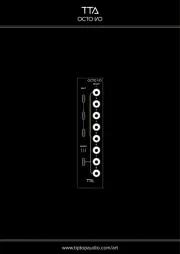
18 Maart 2025

18 Maart 2025

30 Januari 2025

3 Augustus 2023

5 Mei 2023

18 April 2023
Handleiding Niet gecategoriseerd
- Sani-Lav
- Namco Bandai Games
- Parrot
- ATen
- Flex
- Dorman
- Baby Jogger
- Westcott
- Progress
- Infantino
- Novo Nordisk
- Ortlieb
- Elvid
- JAR Systems
- Dave Smith
Nieuwste handleidingen voor Niet gecategoriseerd

14 September 2025

14 September 2025

13 September 2025

13 September 2025

13 September 2025

13 September 2025

13 September 2025

13 September 2025

13 September 2025

13 September 2025